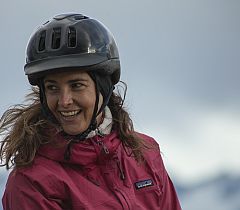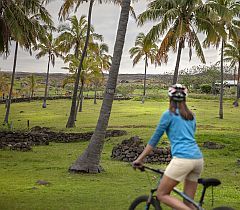Culture, identity and gastronomic research: the incredible culinary commitment of Virgilio Martínez in the Atacama Desert
Virgilio Martínez is the world-renowned chef behind the gastronomic experience at the Explora Atacama lodge in northern Chile. His wealth of experience has led him to create a menu steeped in its sense of place in the driest desert in the world, rich in both biodiversity, human history and its modern day community. In June 2023 Virgilio Martínez's restaurant Central was listed as number one in the world according to The World’s 50 Best Restaurants 2023 ranking. This recognition is just one of the awards the highly decorated chef has received throughout his prestigious career. In this interview, the Peruvian chef also reflects on his participation in the menu design at the Explora Valle Sagrado lodge in his country of origin. He also unpacks the importance of integrating the culture found outside the kitchen when creating a menu, and the essential task for chefs to explore as they continue to innovate.
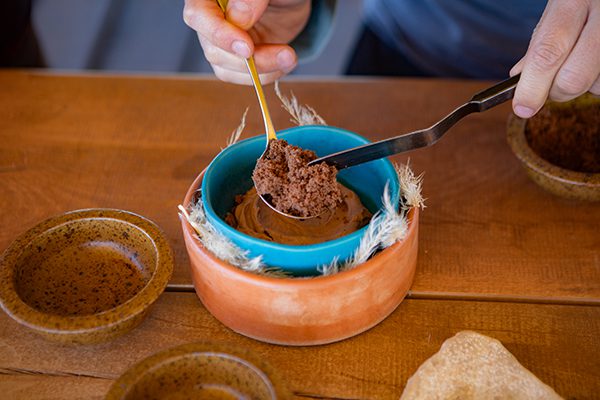
Desert Kitchen
Homegrown, culturally inspired Atacaman cuisine is what Virgilio Martínez´s work is all about at the Explora Atacama lodge. Culinary groundbreaking-research that seeks to rediscover and assimilate the cultural beauty and unique biodiversity of the Chilean north is Martínez´s motif.
Virgilio, what is it that draws you to the Atacama and the desert?
The desert is of great interest to me. Working here is motivating because of the new and unique challenges that come with working in such an environment. In Peru we boast of having it all: of megadiversity and biodiversity. Here they told me there wasn´t a lot going on. I´d totally disagree. Sure there is still a lot to do be done. But I relish the challenge. It´s part and parcel of working in a landscape that is new and rich in promise. Being in a desert does not mean that there are no products. On the contrary, there are many. Here in the Atacama we are probably in the best place to develop a desert cuisine.
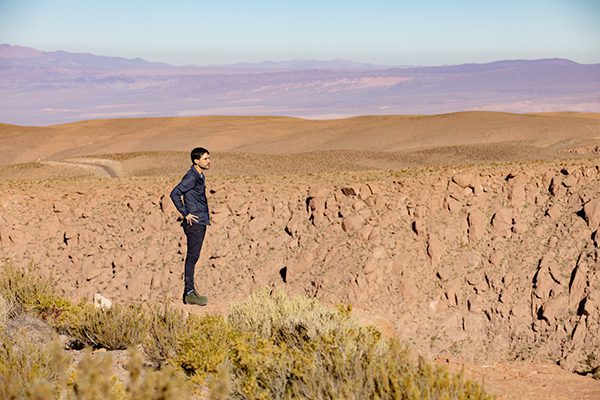
Did you feel at home when you got here?
The opportunity to create desert cuisine in the driest place in the world is very inspiring. Explora, through its spirit of exploring and creating experiences, has pushed me to discover the Atacama, to take trips, and find plants on hikes like rica-rica (a stunted aromatic shrub with small cylindrical branches) or the desert shrub cachiyuyo. Gastronomically, I believe these plants have a tremendous value. I have come to understand that there is so much to discover and rediscover, not only in the field, but also from the Atacama´s communities. Their culinary tradition stretches back hundreds, if not thousands or millions of years.
What characterizes this place?
Local producers, local production and agriculture are never going to be large scale in a desert. But they do exist. When there is very little of something it piques my interest. It instills in you a new way of seeing things. I find it very motivating.
A menu that holds a mirror to the Atacama
Martínez believes that the Atacama is a rich environment for a chef to work; not only in terms of gastronomy but also in culinary presentation and its textures, shapes and sounds. The table service, or even the type of card the menu is made from are all part of a bespoke dining experience.
“The potential for future projects here is enormous. For example, we could collect fallen trees, and print the menu on their paper. Our belief is that inspiration is never far when you step outside. Our true pantry, beyond the refrigerators and the traditional accoutrements of cooking, is the backyard. Our task is to learn and recognize what is in front of our eyes. In the most simple and common place things we can always find different shapes, textures and aesthetics that we can bring to the table,” Martínez insists.
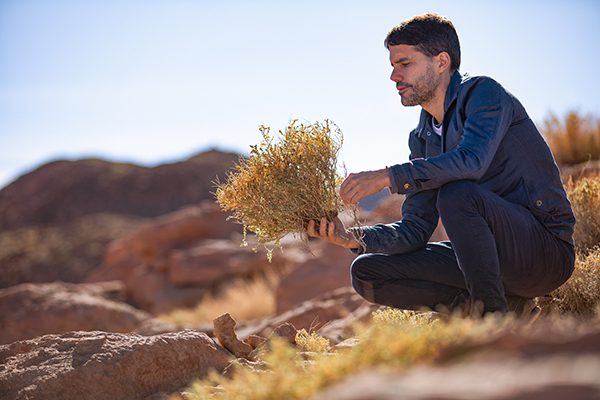
How would you describe your new menu and its gastronomic vision?
The Explora menu is in itself an exploration and is constantly evolving. It changes according to the weather, the seasons, the people, the visitors and in line with our developing understanding of the environment. It´s an offering that will always evolve. This is something positive, motivating and which creates community. I think it´s fair to say that our kitchen is coming to be defined by its strong community-based identity. It is a work in progress. A process that is going to take its time, and I´m happy with that.
Could you tell us about some of the ingredients that have surprised you the most about this place and that you have incorporated into your menu?
I am excited about chañar (Chilean palo verde tree), for example and the natural sweetening it provides; about algarrobo (the flowering and legume producing evergreen carob tree); molles (a sinuous tree producing shiny dense foliage) and the desert shrub cachiyuyo. There are things, such as the way that people use rica-rica here, that have totally new for me. I have not seen that in any other part of the world. Seeing it growing wild on walks is fascinating. Then, there is the seafood. It’s crazy what you find here. Ensuring supply can be challenging but it can be done. That’s why I say the kitchen is in constant evolution. You have to keep the community motivated and reassure them that desert cuisine can be varied. Something from the sea; a lot from the mountains and a menu that reflects what happens here in the desert. Achieving this is how you establish good relationships.
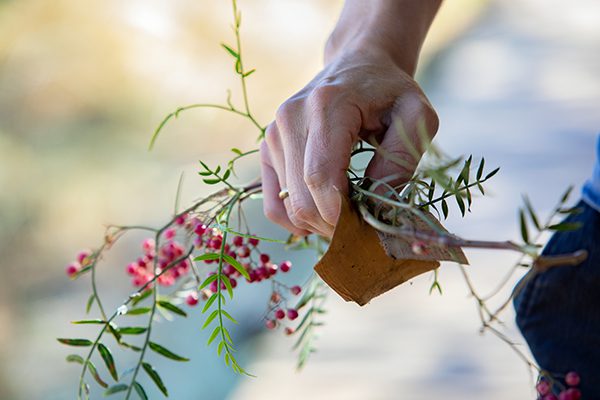
How does the menu change through the seasons?
Well, there is a marked winter season here. We need to hold products back for this time of yar. During most of the year, the menu fluctuates subtly according to seasonality. In winter, however, there are abrupt changes, and its during – let´s say – July, August, September that we bring out certain ingredients to create very different kinds of meals.
What can you tell us about the choices made in the design of the front-of-house restaurant experience?
Well, I think you shouldn’t come to a restaurant with a preconceived idea of how to do things. Yes, we have a framework, from Central, from Mil, from Explora Valle Sagrado, but what is done here is different. You have to communicate the setting here; the sense of the place. You are in the Atacama. The table has to have its own mystique, its own tones and its own colors. You have to take the local people and the visitors into account. So, when I talk about the table, in my opinion, it has to reflect the native plants and the desert. It has to reflect the environment and it has to look varied.
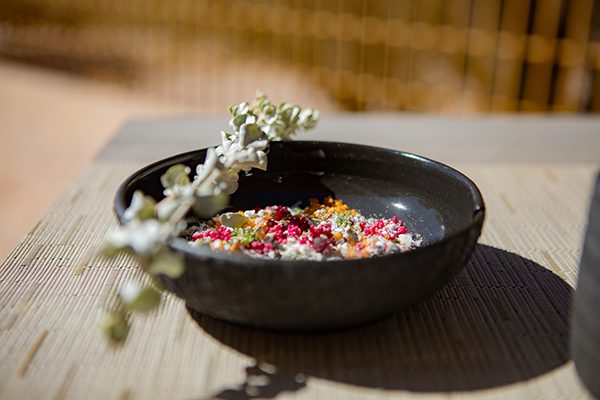
A culinary exploration
Martínez, who is in charge of renowned restaurants such as Central, Mil and Lima, is also the architect of the gastronomic experience at the Explora Valle Sagrado of the Incas lodge. The chef reiterates that the culinary concept at both lodges is part of the exploration experience, and that each of the destinations has its own identity and well as some common ground, such as both having their roots in Andean cultures.
What connections have been created throughout the Andean world as a result of your work in both the Sacred Valley and the Atacama?
Well, the most fascinating part has been discovering that borders in the Andes don´t create boundaries. What works in the Peruvian Andes is totally applicable in the Chilean Andes. Sure there are some variables. Not all of the Andes is alike, but there are many processes, products, knowledge systems and forms of agriculture that are very similar. So, if we apply these established ways of doing things well, we find we already have a very strong foothold to start from.
Virgilio Martínez travels, imagines and takes the pulse of the infinite possibilities of the desert landscape. One sure way to grow, the chef believes, is to embrace the unknown. This impulse, he believes, takes creativity to the next level.
“What I repeatedly experience in the desert when I take a walk or explore with the kitchen team is a very different color palette to that which I am used to in Peru. There it is very colorful. That´s not the case here. The colors are more subdued. There are different sounds and much greater silence.”
What links can be drawn between your culinary concepts and the idea of deep exploration as promoted by Explora?
Well, when I first heard about Explora, the very name motivated me to learn what they did. I subsequently witnessed how they led explorations into places that other people just weren´t reaching. That is what our kitchen does. We are a great match, with a common goal of giving people the chance to explore. People who sit at the Explora table come with their curiosity heightened by what they have been living, experiencing, smelling and feeling during their walks and activities during the day; so why not reflect that by giving them something that reminds them of what they have been experiencing.
Martínez has conducted research and exploration in a wealth of locations for more than fifteen years, working alongside varying communities to create multidisciplinary teams, with a clear focus on the value of what can be found beyond the kitchen.
“The kitchen is great; we use creative state-of-the-art techniques. But let’s not forget: there is much more outside. Going out into the field, meeting local producers, farmers and communities builds knowledge and establishes relationships. To really understand the gastronomic traditions of a place – for example techniques for preservation or the ways a particular product was used historically – I think that has real value,” says the decorated chef.
